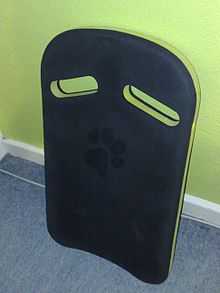Swimming float

A swimming float is normally used for toddlers or other very young children who are beginning to learn how to swim, or during exercise for therapeutic or training purposes. These devices, which come in many shapes and types, are used to aid them with buoyancy.
The most common floats for children are inflatable rings (where the user swims in the middle of it) and the inflatable armbands (they are placed around the user's arms). After being inflated through a valve, they are much less dense than water because they are composed mainly of air, surrounded by a thin layer of synthetic material.
Swimming float-assisted can be more difficult than swimming without the float, because if the float is held in front of the swimmer a more vigorous workout for the legs is given as the swimmer's weight is propelled solely by the legs, and vice versa for the arms.
A variation known as the "pool noodle" is a long (about 3 feet (0.91 m)–4 feet (1.2 m)) thin (a few inches across) cylinder with a hollow core. It can be used to aid in floating or stretching exercises.
A pull buoy or "leg float" is used to focus exercise on the arms.
Pool dumbbells are used for strength training where muscles push down against buoyancy. This is the opposite of conventional dumbbells, which are used to force muscles to pull up, against gravity.
Swimming board

Swimmers of all ability can use them. Young swimmers can develop their kicking action while elite swimmers can refine their kick. They are also used to strengthen a swimmers legs.[1]
Construction

Variations
There are some variations of kickboards from the traditional form with two hand grips. Some can be used as a kickboard and a pull buoy. These are often oddly shaped so they can be used for both of the training aspects.
See also
| Wikimedia Commons has media related to Swimming floats. |
References
| |||||||||||||||||